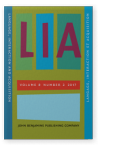Vol. 8:2 (2017) ► pp.234–272
Towards the use of phonological markedness and extraprosodicity in accounting for morphological errors in Specific Language Impairment
Certain grammatical morphemes are variably produced in the speech of children with Specific Language Impairment (SLI). Previous research tends to view this as a consequence of either a deficit in linguistic knowledge or a limitation in processing capacity; however, both approaches raise problems. For example, linguistic accounts are unable to explain why these children’s problems are mostly with production rather than comprehension. Processing accounts, on the other hand, have difficulty explaining why affected children have differing levels of problems with grammatical morphemes that are similar on the surface (e.g. English plural -s vs. third person singular -s). In this paper, a new, phonological account is proposed which avoids these problems, and better captures the wide array of data presented in the literature. It is proposed that children with SLI have problems with organizing segmental data into prosodic structures that are linguistically highly marked, in particular those that involve various forms of extraprosodicity.
Article outline
- 1.Introduction
- 2.SLI and theoretical issues
- 2.1Previous accounts of SLI
- 2.1.1Linguistic accounts
- 2.1.1.1The Extended Optional Infinitives Account (EOIA) and its successors
- 2.1.1.2The Agreement Deficit Model
- 2.1.1.3The Deficit in Computational Grammatical Complexity Model (CGC)
- 2.1.2Processing accounts
- 2.1.2.1The Surface Account
- 2.1.2.2The morphological richness account
- 2.1.2.3The phonological memory deficits account
- 2.1.1Linguistic accounts
- 2.2Problems with previous accounts
- 2.2.1Linguistic accounts
- 2.2.2Processing accounts
- 2.1Previous accounts of SLI
- 3.Current account
- 3.1Phonological markedness and extraprosodicity as a clinical marker of SLI
- 3.2Prosodic Phonology, extraprosodicity and markedness of various prosodic structures
- 3.3Prosodic status of morphemes problematic for SLI vs. other morphemes
- 3.4Main argument
- 4.Further discussion and cross-linguistic evidence
- 5.Conclusion
- Notes
-
References
This article is currently available as a sample article.
